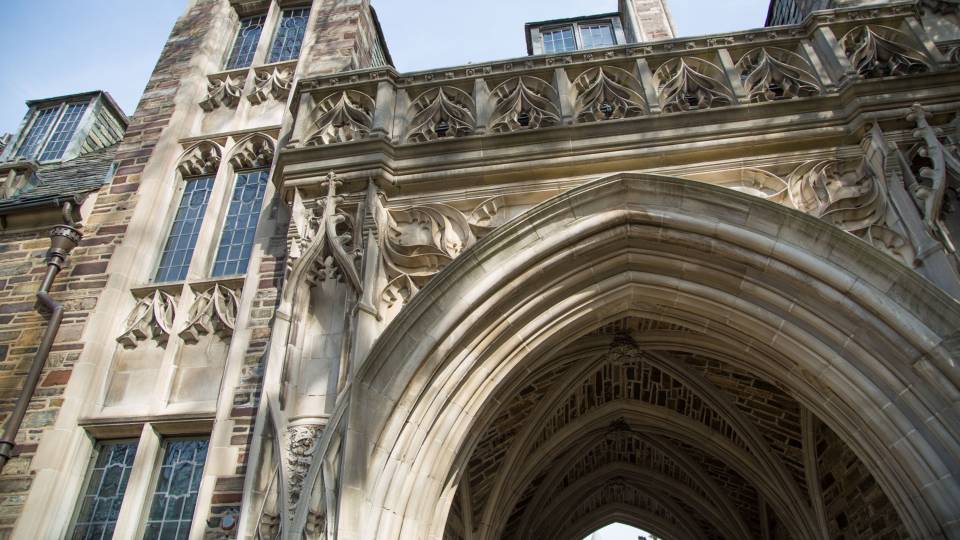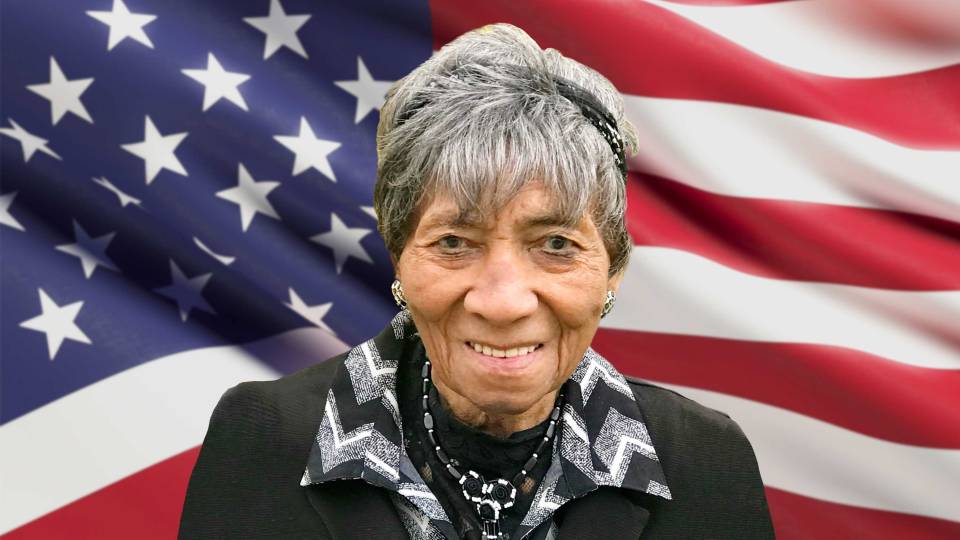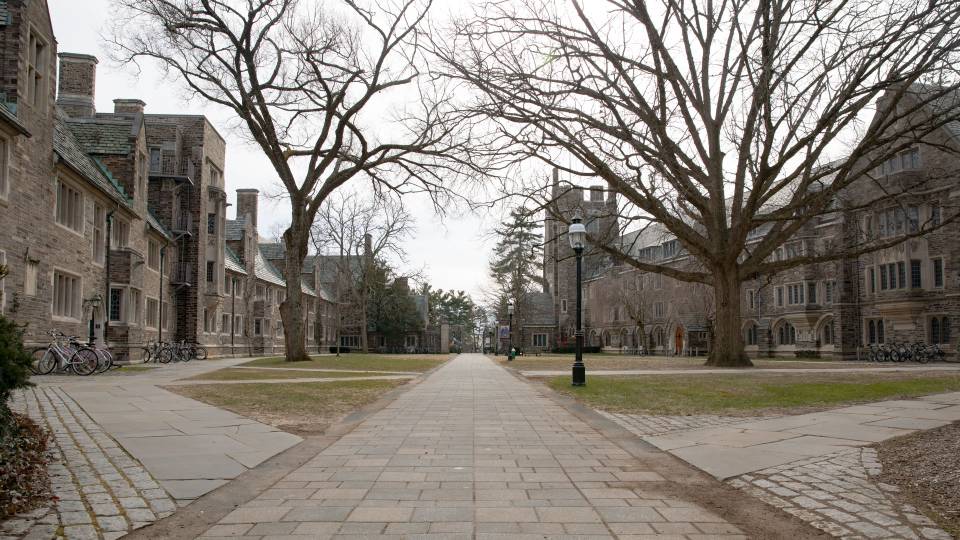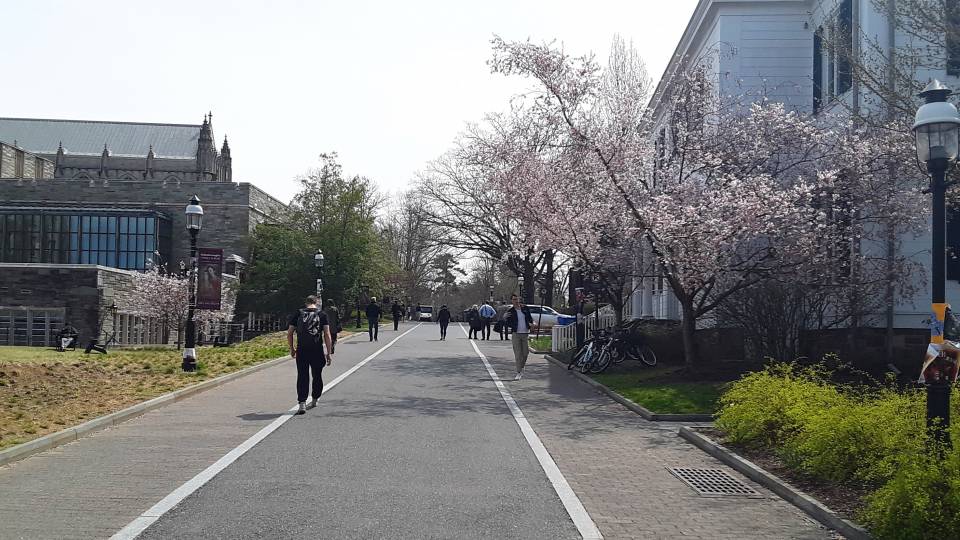Princeton has named the 1928 Gothic limestone archway at Lockhart Hall for Kentaro Ikeda, Class of 1944.
Generations have passed through the Gothic limestone archway set into Lockhart Hall since it was built in 1928. Last week, Princeton University named the historic passage connecting McCosh Walk to University Place in honor of one of the dormitory’s former residents, Kentaro Ikeda, to be remembered by generations to come.
Last year, Princeton’s Board of Trustees approved naming the Lockhart Hall archway in honor of Ikeda, Class of 1944, the University’s sole Japanese student during World War II, who was confined to Princeton’s campus as people of Japanese descent were being incarcerated across the U.S. under wartime restrictions.
“Kentaro Ikeda’s story is a stark reminder of the complicated histories of this country and our University,” said President Christopher L. Eisgruber at a ribbon cutting and dedication, held on Sept. 13. “Decades after the war, the U.S. government formally apologized for the treatment of Japanese people during World War II. With this naming, we honor Kentaro’s experience at Princeton during the war and his inspiring persistence in the face of adversity. As future generations of Princetonians traverse our campus, they too will come to know his remarkable story.”



Ikeda, a Japanese national, was confined to Princeton’s campus beginning in 1942, when the U.S. issued an executive order authorizing the government to incarcerate people of Japanese descent.
A plaque inside Ikeda Arch recounts the complicated history behind Ikeda’s confinement and his resilience in the face of adversity.
The historic archway, part of Lockhart Hall, connects McCosh Walk with University Place. Ikeda lived in the dormitory as a Princeton student.
Dozens gathered in the courtyard in front of Lockhart Hall for the dedication ceremony, including Ikeda’s widow, Young Yang Chung, who performed the ribbon cutting with Eisgruber and University officials Michele Minter, vice provost for institutional equity and diversity, and Beth Lew-Williams, associate professor of history and chair of the Council of the Princeton University Community (CPUC) Committee on Naming, which recommended naming a campus space in Ikeda’s honor.
Eisgruber said the naming “marks another important step forward” as the University engages in a serious reflection of its history and seeks ways to develop a more complete narrative.
Ikeda was born in Kanazawa, Japan, and moved to New Jersey in 1938 to attend boarding school. During his sophomore year at Princeton, Japan attacked Pearl Harbor and the United States entered World War II. In February 1942, the U.S. issued an executive order authorizing the government to incarcerate people of Japanese descent, including U.S. citizens, in internment camps.
Ikeda worked with the federal government and the University to avoid deportation and imprisonment, but was essentially confined to Princeton. He was prohibited by wartime restrictions from leaving town without permission, from accessing funds and from communicating with anyone in Japan, including his family.
After the war ended, Ikeda stayed in the U.S. with support from American friends and from Princeton administrators and others who helped him gain a visa extension. Later, he was able to legally immigrate to the U.S. and remained in the country for the rest of his life. He was a well-known tea importer in his family’s business and a longtime resident of Larchmont, New York.
In a speech delivered at the dedication, Lew-Williams, who is also the director of the Program in Asian American Studies, said she has taught students about Ikeda for years and has had many opportunities with them to consider Ikeda’s legacy.

Ikeda Arch was dedicated on Sept. 13 in a ceremony attended by Ikeda’s widow, Young Yang Chung (second from left). She was accompanied in a ribbon-cutting for the archway by (left to right) Michele Minter, vice provost for institutional equity and diversity, President Christopher L. Eisgruber and Beth Lew-Williams, associate professor of history and chair of the Council of the Princeton University Community Committee on Naming.
“What his story means in the context of Asian American history and in the context of this University is not simple,” she said. “He does not fit the mold of the basic narrative about Japanese incarceration during World War II.”
On the one hand, she said, the University protected Ikeda, but it also acted essentially as his jailer. This history is also problematic in that Princeton did not take in additional Japanese students, as other institutions on the East Coast did.
“By honoring Ikeda’s strength and recognizing this history,” she said, “we strive to build a University, and a society, in which the wrongs he suffered are no longer possible.”
Minter, who also gave remarks, said Ikeda’s “challenging and courageous experience at Princeton will serve as a permanent reminder of the ways that the University has changed over time.”
“On the University campus, we are surrounded by history, literally built into the walls and embodied in the landscape,” she said. “If we are attentive to the people and events of the past, these stories can inform our understanding of the diversity and complexity of Princeton’s history, while better reflecting the present and our aspirations for the future.”
The CPUC Committee on Naming, which is made up of faculty, staff, graduate student, undergraduate and alumni representatives, provides advice to the Board of Trustees regarding the naming of programs, positions and spaces at the University.
Since 2016, the University has named a number of spaces with input from the CPUC naming committee, including:
- The former Marx Hall was named Laura Wooten Hall in honor of the late Laura Wooten, who worked in Campus Dining for 27 years and was recognized as the longest serving poll worker in the U.S.
- The former West College was named Morrison Hall in honor of Nobel laureate and former Princeton faculty member Toni Morrison.
- The auditorium in Robertson Hall was named Arthur Lewis Auditorium in honor of Nobel laureate and former Princeton faculty member Sir W. Arthur Lewis.
- The publicly accessible garden between Firestone Library and Nassau Street was named for Betsey Stockton, a formerly enslaved woman, educator and leader in Princeton’s Black community in the 19th century.
- The easternmost arch in East Pyne Hall was named for James Collins Johnson, a formerly enslaved man who worked on campus for more than 60 years before his death in 1902.
- The roadway that enters the campus from Nassau Street between Firestone Library and the buildings of the Andlinger Center for the Humanities was named for pioneering Black alumnus and longtime Princeton resident Robert J. Rivers Jr.
- The courtyard among Henry, Foulke, Laughlin and 1901 residence halls was named the Beatrix Farrand Courtyard in honor of Farrand, who was the University’s landscape architect from 1912-43 and helped shape the distinctive look of Princeton’s grounds.

Young Yang Chung (left) and her son David Yoo, Ikeda’s stepson, leave the dedication ceremony through the newly named Ikeda Arch.







